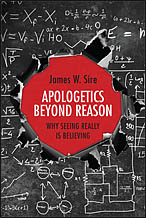Apologetics Beyond Reason: Why Seeing Really Is Believing
By James W. Sire
My rating: 4 of 5 stars
There is everything.
Therefore there is a God.
Either you see this or you don’t.
This epigraph at the beginning of James W. Sire’s latest book captures the “apologetic” for the Christian faith that Sire proposes. In the course of the book, he rings the changes on this syllogism, substituting for “everything” the terms “literature” and “the music of Johann Sebastian Bach” among others.
What he addresses here are the limits of reason to “prove” the existence of God or indeed to convince someone of the truth of the Christian faith. Using his own life story as an illustration, he contends for a “messy” approach to apologetics that is neither deductive or inductive but rooted in the idea that there are “signals of transcendence” that we might encounter wherever we look that point us to God and which are made sense of by the narrative of creation, fall and redemption we find in the story of scripture.
He begins with his encounters with Cartesian philosophy and the autonomy of human reason and the ultimate futility and implicit nihilism that results when human reason is pursued to its logical conclusions illustrated in the works of science fiction writer Stanislas Lem. There is a conundrum is using autonomous reason to articulate the futility of autonomous reason that in itself is a signal of transcendence. But where does one start?
Instead of reason as a starting point, Sire argues that the only place to begin is with God. That is, we don’t begin with what we can know, or epistemology, but rather with being itself, or ontology. We begin with God to know everything else (and either we see this or we don’t!). Sire proposes a threefold argument from this starting point:
- An argument from God, not to God.
- An argument from everything to God.
- An argument from our personal experience —direct perception of God.
The remainder of the book is an unpacking of this argument from the world of literature and the arts interwoven with his personal experience. He begins with a literary theory of the work of authors in creating a “secondary world” that, when done well, points us back to the “primary world” in which we live. Thus, whether the writer believes in a God or not, Sire argues, he or she cannot help but signal the transcendent in their work. He illustrates this with both the works of a Christian, Gerard Manley Hopkins, and the work of Virginia Woolf. If there is indeed a God, we cannot create a world that is reflective of Primary reality without also pointing back to God and opening oneself to the possibility of directly perceive the reality of God. He then illustrates this with the fictional account of a bereaved professor from a fictional college in Ohio that seemed to me reminiscent of A Severe Mercy by Sheldon Van Auken.
The concluding chapter moves from our perception, our seeing of God, to the story Sire believes makes the most sense of what we perceive of God and the rest of Primary Reality. He invites the reader to move beyond the signals to the One signaled, narrated in the Christian scriptures and centering in on Jesus Christ, who incarnated the reality of God.
I should confess at this point that I am at least a casual friend of the author. He has spoken on several occasions at collegiate ministry functions I have hosted. We have teamed up as program staff at student conferences. So there is no question of me being a sympathetic reader of his work. The argument he makes is one with which I would concur. But a couple of comments are probably in order.
As I’ve interacted with questioners about the Christian faith, I often find myself asking, “do you want there to be a God?” and “if I were to give reasonable responses to your questions, would you consider becoming a Christian?” I’m well aware that others see the same reality I do and just “don’t see” or don’t want to. Sire really doesn’t address the question of “what about those who don’t see?” And perhaps there is nothing to be said but to commend them to God in our prayers.
The other comment is that Sire argues from literature throughout the central part of this book. This is beloved ground for him and there will be others who appreciate the subtleties in the literature he cites. It is a world I am increasingly coming to enjoy. Yet I realized a great many do not know this world or are even put off by it. I don’t think there is a good response for this except to say to follow the thread of the argument, which connects to everything, and not simply everything in literature.
Sire’s book comes out of a career of teaching, writing, and serving as a traveling apologist. It reflects great wisdom in understanding both the messiness of apologetics and the reality that it will often be those signals of transcendence and our perception of them that will lead to faith. But as he has written, either his readers will see this, or they won’t.

Thank-you to Bob for sharing Apologetics Beyond Reason Why Seeing Really Is Believing from his blog Bob on Books. James W. Sire and his labors with InterVarsity Press have been a great encouragement to Emerging Scholars before the launch of and throughout the continued development of the Emerging Scholars Network (ESN). Thank-you Jim!
For ESN’s focused blog interaction with Jim and his work visit here. Stay tuned for more. To God be the glory! ~ Thomas B. Grosh IV, Associate Director, Emerging Scholars Network
Bob Trube is a former Associate Director of Faculty Ministry and Director of the Emerging Scholars Network. He blogs on books regularly at bobonbooks.com. He resides in Columbus, Ohio, with Marilyn and enjoys reading, gardening, choral singing, and plein air painting.


Bob, this is probably the best review I’ve ever read by you. Well done, well said. Perhaps it is because of our friendship and mutual casual friendship and my love of the subject matter. It seemed to me as one who has also enjoyed this book and enjoyed the thinking and writing of this author over the years that I was on the same page with you completely. Wow, great review. Great links at the end also.
Thanks Joe! Perhaps one reads and writes more carefully when the work is by one of your friends. Grateful for both Jim and you and the common mission that has brought us together!